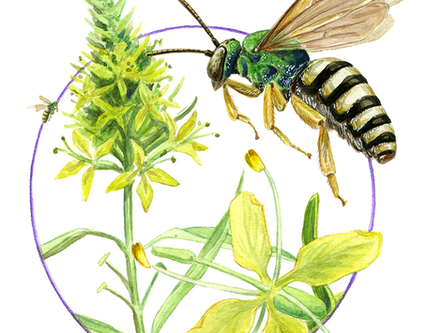top of page

NEWS
STAY UP-TO-DATE ON PPAN HAPPENINGS
HERE & ON SOCIAL MEDIA


Xenoglossa strenua, Squash Bee
Xenoglossa strenua is one species of solitary, ground-nesting bees commonly known as Squash Bees . They are specialist pollinators, relying almost exclusively on one type of plant -in this case, squashes, pumpkins, and gourds. The adults are attracted to the distinctive scent of the flowers and can be found foraging around dawn. Their activity tapers off by mid-morning, though sleepy males may be found resting inside the flowers throughout the day. Females prefer to dig indiv
pollinators1
Oct 15


Vella fallax, Antlion
Vella fallax belongs to a group of insects called Antlions . The relatively large size of the adults might seem intimidating; however, they are completely harmless to humans, feeding primarily on nectar and pollen. It is the larvae that have helped them earn their predatory name! They construct pit traps in loose soil and lie in wait just beneath the surface. When ants or other insects fall in, the larva grabs its prey with massive, curved jaws and drags it underground to
pollinators1
Oct 15


Megachile parallela, Parallel Leaf Cutter Bee
The Parallel Leaf Cutter Bee ( Megachile parallela ) is a solitary species with remarkable architectural skills and a strong preference for sunflowers, particularly Nuttall's sunflower found throughout Colorado's plains and foothills. Females use their powerful mandibles to cut precise semicircular pieces from leaves, which they carry back to their nests tucked under their bodies. These leaf fragments are used to construct waterproof brood cells within existing cavities like
pollinators1
Oct 15


Libellula pulchella, Twelve Spotted Skimmer
The Twelve Spotted Skimmer ( Libellula pulchella ) is a large, conspicuous dragonfly commonly found around Colorado's ponds, lakes, and slow-moving streams where sedges grow along the water's edge. Males are territorial, perching on prominent sedge stems while scanning for prey and rivals with their enormous compound eyes that can detect movement across nearly 360 degrees. Their spotted wings create distinctive flight patterns as they hunt mosquitoes, midges, and other flyi
pollinators1
Oct 15


Hemaris diffinis, Snowberry Clearwing Moth
With their dramatic transparent wings, fuzzy striped bodies, and hovering flight pattern, Snowberry Clearwing Moths ( Hemaris diffinis ) are often mistaken for small hummingbirds or large bumblebees by both predators and human observers alike. Their well-camouflaged caterpillars are called hornworms due to the prominent spike on their rear end. They feed on snowberry shrubs and other members of the honeysuckle family, helping to regulate plant populations and maintain ecolog
pollinators1
Oct 15


Bombus huntii, Hunt's Bumble Bee
The Hunt Bumble Bee ( Bombus huntii ) is one of Colorado’s distinctive medium sized bumblebees with a colorful rust-orange band on their fuzzy rump. Their ability to thrive in cooler temperatures and “buzz pollinate” makes them important generalist pollinators in both natural and agricultural ecosystems across our state! Like other bumble bees, they nest underground in small colonies, and only fertilized young queens survive the winter. These queens emerge in spring to loc
pollinators1
Oct 15


Boloria acrocnema, Uncompahgre Fritillary Butterfly
The Uncompahgre Fritillary ( Boloria acrocnema ) is one of Colorado’s rarest butterflies. Federally listed as an Endangered Species, it is found in only a few isolated populations above 12,000 feet in the San Juan Mountains. Adapted to harsh alpine conditions, adults are active for just a few weeks in June and July following the seasonal snowmelt. Adults are generalist pollinators of high-elevation wildflowers, while their life cycle is closely tied to the snow willow, a low
pollinators1
Oct 15


Apis mellifera, Honey Bee
Though not native to North America, honey bees ( Apis mellifera ) have become integral to Colorado's agricultural landscape, particularly in alfalfa production across the state's eastern plains. These social insects live in highly organized colonies with complex communication systems, including the famous "waggle dance" that conveys distance and direction to food sources. Alfalfa's purple flowers provide excellent nectar flow, though the crop's "tripping" mechanism can someti
pollinators1
Oct 15


Toxomerus marginatus, Margined Calligrapher Syrphid Fly
Margined Calligrapher Syrphid Flies (Toxomerus marginatus) are widely distributed across North America, from Canada to Mexico. Their bright yellow and black markings closely resemble the warning coloration of stinging insects like wasps and honeybees, however, unlike the insects they mimic, these flies are harmless to humans and do not sting. As adults, they feed on nectar and pollen, and are essential for pollinating a wide diversity of plants. Additionally, their larvae
pollinators1
Oct 15


Tegeticula yuccasella, Yucca Moth
Tegeticula yuccasella, a species of Yucca Moth , shares an important mutualistic relationship with Soapweed Yucca (Yucca glauca), common across Colorado’s arid prairies and foothills. In spring, the adult moths emerge from their cocoons in sync with yucca flowers. Female moths collect pollen, mate, and deposit eggs across various individual yucca plants, facilitating vital cross-pollination and seed production. Emerging larvae consume only some of the yucca seeds in a way th
pollinators1
Oct 15


Osmia lignaria, Blue Orchard Bee
The Blue Orchard Bee (Osmia lignaria) stands out with its eye-catching metallic blue-black color! Like most of Colorado’s 1,000+ native bee species, these solitary bees build individual nests, rather than live in colonies, and often select natural cavities found in wood or hollow stems. To ensure direct and efficient pollen transfer between flowers, they carry collected pollen on the undersides of their bodies. This trait, along with their tendency to revisit the same type
pollinators1
Oct 15


Hypaurotis crysalus, Colorado Hairstreak Butterfly
The Colorado Hairstreak butterfly (Hypaurotis crysalus) became our official state insect in 1996, thanks to a campaign led by Colorado 4th graders! These beauties are dependent on Gambel Oak for their lifecycle—a native shrub found in the lower montane regions of western and southern Colorado, as well as along the Front Range. Though their wings are iridescent purple, this butterfly is well camouflaged against the bark and leaves of the oak, due to the small black and oran
pollinators1
Oct 15


Hetaerina americana, American Rubyspot Damselfly
American Rubyspot damselflies (Hetaerina americana) add a splash of color to stream and river habitats across North America. Males have vibrant red spots at the base of their wings, and contrasting bright green abdomens, while females are generally metallic green and gold. Damselflies are sensitive to pollution and their presence or absence can be an important indicator of the health of our critical freshwater ecosystems. Males aggressively defend territories at the edge of
pollinators1
Oct 15


Dufourea maura, Black Short-faced Bee
Dufourea maura (Black Short-faced Bees) are specialists on one of Colorado’s most eye-catching wildflowers -the Harebell ( Campanula sp .)! These conspicuous violet bell-shaped flowers impress humans and pollinators alike in alpine and subalpine meadows across the state. The adult bees are active in summer and early fall when these plants are blooming, and their range is completely dependent on the range of their host plant. The fate of specialist pollinators is closely ti
pollinators1
Oct 15


Cicindela theatina, Great Sand Dunes Tiger Beetle
Great Sand Dunes Tiger Beetles (Cicindela theatina), named for their distinctive coloring and predatory behaviors, are found only in Colorado's Great Sand Dunes National Park. This unique habitat supports over 1000 species of arthropods (insects, spiders, centipedes, millipedes), including several other species of insects that are found nowhere else in the world! Adult Tiger Beetles actively hunt other insects using their long legs and powerful jaws; while the buried lar
pollinators1
Oct 15


Bombus occidentalis, Western Bumblebee
Bombus occidentalis, the Western Bumblebee , inhabits a wide array of environments in western North America—from lowland agricultural areas to high alpine meadows. They are generalist pollinators that contribute significantly to the health and productivity of both Colorado’s native ecosystems and agricultural landscapes. Bumblebees are able to fly in cooler temperatures and lower light levels than many other bees, and their robust, hairy bodies help them efficiently move larg
pollinators1
Oct 15


Anthophora pueblo, Pueblo Digger Bee
The Pueblo Digger Bee ( Anthophora pueblo ) is named in honor of the ancestral Pueblo peoples, who built cliff dwellings in the Four Corners region more than 700 years ago. These industrious, solitary bees use their mandibles to chew away at the sandstone—creating a network of tunnels and nesting chambers for egg-laying and larval development. Nesting sites have been found in Utah, California, Nevada, and Colorado, including Mesa Verde National Park. Sandstone is more durabl
pollinators1
Oct 15


Agapostemon coloradinus, Colorado Striped Sweat Bee
Agapostemon coloradinus (the Colorado Striped Sweat Bee ) is a colorful creature named after a colorful state! Males have dazzling metallic green upper bodies, and abdomens with distinctive yellow and black stripes. Females lack stripes, but do have bands of short white hairs on their undersides, which help them carry pollen to their underground nests. These non-stinging solitary bees have been found in a variety of habitats, and while their range may stretch across the Sout
pollinators1
Oct 15
bottom of page










